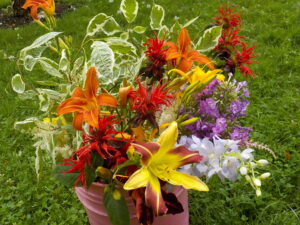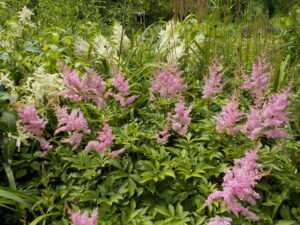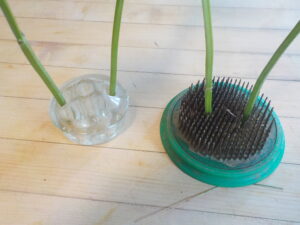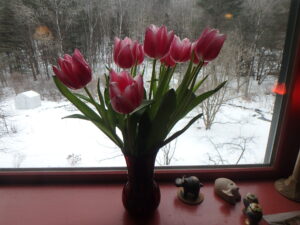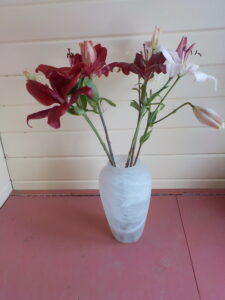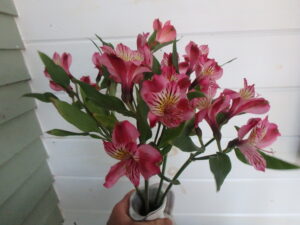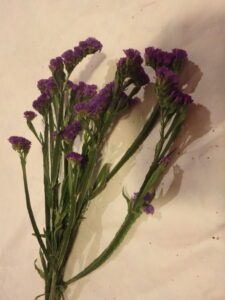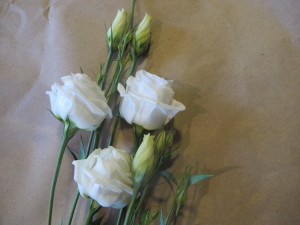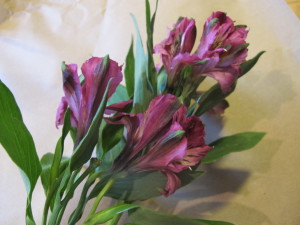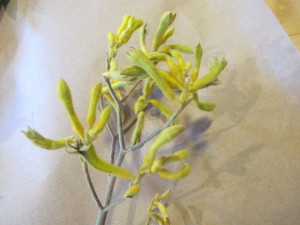Tips for picking and arranging flowers
I’ve been keeping track this year of what blooms for me, and when. So far I’ve recorded over 100 species of flowers (plus many more named varieties of the same genus) and 40 species of flowering trees and shrubs. Blooming starts with snowdrops in March and will continue on until well after frost in November with witchhazel trees blooming even after leaf drop.
Flowers with multiple blossoms on a stem (delphinium, foxglove, for example) should have some blossoms in full bloom, others showing color and some in tight bud. This will prolong the show. Flowers that grow on individual stems should be in full bloom, or just starting to open. Peonies, for example, will often have tight buds on the same stem as an open blossoms, but it is rare for them to bloom in the vase. Daylilies only bloom for a day, but a single scape can have up to 10 buds that will bloom in sequence for a week or more.
Be sure to remove all leaves or flowers that would be submersed is the vase you are using. Why? The leaves will rot and ferment; the bacteria will inhibit water uptake.
To my eye, a 6-inch vase will look good with 9-to12-inch flowers in it, but even 18-inch stems may look fine, especially of you place shorter flowers around the outside perimeter of the arrangement. I made an arrangement recently with six stems of beebalm in an 8-inch vase. I angled the stems to create support for a 24-inch stem of delphinium in the middle, standing straight up. That looked great to me.
Tips for Buying and Enjoying Cut Flowers
Winter drags on, even though the days are getting longer. The sun is often lurking behind gray clouds, and on a good day we only get about 9 hours of light. I do miss the colors of summer, so I keep fresh cut flowers on our table – even though I have to buy them.
Here are some things you can do to promote longer vase life: cut off leaves that would enter the water in your vase. Leaves will rot, promoting growth of bacteria, which will impede water take-up. Cut off half to three quarters of an inch of each stem every few days, and change the water. Use the packets of white powder that often comes with flowers – it does help.
- Lisianthus: These look like silk flowers to me: perfect white, pink or lavender-colored bell-shaped flowers on long stems. Tough to grow in the garden, they are perfect in a vase – I’ve kept them for up to 3 weeks.
- Miniature carnations: Each stem has 2-4 blossoms. They come in a variety of colors. Mix dark red “minis” with red roses to make a bouquet of roses look fuller. And even after the roses go to Valhalla, the carnations will still be good!
- Chrysanthemums: These come in a variety of sizes and colors, from the huge spider mums to little guys. I love the scent of the flowers –it’s not overpowering, but it’s there if you sniff them.
- Statice. I grow these for use as dry flowers, which tells you that they really do last forever – even out of water. They come in blue, purple, pink and white.
-
Spray roses: Instead of a single blossom per stem, these have 2-5 blossoms, giving you more bang for your buck. These will last about a week – or even more with proper care
- Alstromeria: One of the best for long life. Each long stem has clusters of 2-inch lily-like blossoms in pinks and reds, with yellow throats. If you buy them in bud, they will look good for three weeks!
- Orchids: While not cheap, orchids as cut flowers can last up to a month. I love dendrobiums, though they are not common, even in floral shops. Cymbidiums have bigger blossoms and also last extremely well.
- Kangaroo paws: These Australian natives are fuzzy and cute. They come in pinks, reds, orange and brown, and last very well. Not every florist will have them.
- Asiatic lilies: I recently got a bouquet of five nice stems grown in New Hampshire that was sold at my local Coop food store. For $12.95, they will bloom with great elegance.
You may wish to ask where the flowers you plan to buy are from. Holland, Columbia, Ecuador and Kenya are the world’s top growers and export much of what is available. Some foreign growers have been criticized for producing flowers using strong pesticides and poor labor practices. The Sun Valley group in California is an excellent major American grower of cut flowers – but there is still the environmental cost of shipping them 3,000 miles to us. If you can buy flowers grown locally in greenhouses, do it!
Buying Cut Flowers
Technically, winter is here – despite the lack of snow. The sun is often lurking behind gray clouds, and on a good day we get just 9 hours of light. I miss the colors of summer. I still try to keep fresh cut flowers on the table – even if they’re not flowers from my garden.
Cut flowers are among modern America’s true bargains. For the price of a bottle of wine – or even a few of cups of fancy coffee – you can buy flowers that will grace your table for up to three weeks. But there are some things you should know about getting good table-life for your investment.
First, you need to buy fresh flowers that have been carefully tended – and you can’t beat a florist for that. Yes, grocery stores sell bouquets, but many grocery stores sell bouquets in the fruit and vegetable department. Apples and some other fruits give off ethylene gas, which promotes ripening – or in the case of flowers, getting old and unattractive.
Cut flowers need to take up water to stay fresh and healthy. Stems tend to scab over after a day or two, which means they cannot take up replacement water, or not much, so they suffer. A floral shop has trained personnel who trim each stem in the store every other day, taking off three quarters of an inch each time. And someone who regularly changes the water to keep to keep it fresh. Chain grocery stores probably count on you buying their flowers before the flowers need to be trimmed or their water changed.
When you bring your flowers home, get them right in water. And follow the 3-second rule: never take longer than 3 seconds to get your flowers in the vase after trimming the stems. Most florists give you packs of powder to put in the water, and the stuff works to keep flowers fresh longer. It inhibits bacteria from growing, which is good. Bacteria will impede water take-up.
If you want maximum life out of you flowers, NEVER let leaves enter the water. Leaves will rot, promoting growth of bacteria. And keep your arrangement cool if you can. Putting it near a radiator or woodstove will shorten its life. If you have invested in roses or tulips, you may wish to move the vase to the entryway or mudroom at bedtime to keep the flowers extra cool during the night – or put them in the fridge.
Some flowers are better picks than others if you’re on a budget and can’t afford to buy new flowers every week. Here are my recommendations for good cut flowers:
- Lisianthus: These look like silk flowers to me: perfect white, pink or lavender-colored bell-shaped flowers on long stems. Tough to grow in the garden, they are perfect in a vase – I’ve kept them for up to 3 weeks.
- Miniature carnations: Each stem has 2 to 4 blossoms. They come in a variety of colors. Mix dark red “minis” with red roses to make a bouquet of roses look fuller. And even after the roses go to
Valhalla, the carnations will still be good!
- Chrysanthemums: These come in a variety of sizes and colors, from the huge spider mums to little guys. I love the scent of the flowers –it’s not overpowering, but it’s there if you sniff them.
- Statice. I grow these for use as dry flowers, which tells you that they really do last forever – even out of water. They come in blue, purple, pink and white.
- Spray roses: Instead of a single blossom per stem, these have 2-5 blossoms, giving you more bang for your buck. Will last about a week with proper care
- Alstromeria: Each long stem has clusters of 2-inch lily-like blossoms in pinks and reds, with yellow throats. Very long-lived. Great value.
- Kangaroo paws: These Australian natives are fuzzy and cute. They come in pinks, reds and browns, and last very well. Not every florist will have them, but ask.
Looking for a fun project with your kids? It’s easy to change the colors of chrysanthemums. Leave them out of water for 12 hours, then cut off 2-3 inches and put them in water with food coloring. Obviously, you should start with white chrysanthemums. The colors you get may not be exactly the color you see on the food coloring, but it can be quite dramatic.
Everyone loves to receive the gift of cut flowers, even guys. So treat your loved one – or yourself- to fresh flowers this winter. They’re cheerful, and can make winter less oppressive.
Henry is the author of 4 gardening books, including a new, revised second edition of The New Hampshire Gardener’s Companion: An Insider’s Guide to Gardening in the Granite State. His website is www.Gardening-guy.com.
Cut Flowers
Conventional wisdom has it that most cut flowers come from Central or South America, many grown using underpaid, poorly treated laborers and toxic chemicals that are banned in the United States. I decided to look into the cut flower industry, and started by reading Amy Stewart’s book, Flower Confidential. It’s a good read and very informative. I also spoke to the head of the Sun Valley Group, the number one producer of cut flowers in America.
Unlike consumers in Europe, Americans apparently don’t really care where their cut flowers were grown – or how. We care about how they look, how long they last in a vase, but mostly we care about the cost. Overall, we are cheap when it comes to buying flowers. We may pay extra for organic coffee or fair trade bananas, but flowers? Nope. We just don’t seem to care.
I spoke to retired florist Lynn Schad, who told me that when she prepared roses for bouquets she sensed that she was being exposed to toxins, and worried about it. There was nothing she could prove, but the way her hands and breathing felt after handling roses told her that there were chemicals on the roses. Strong chemicals.
Flower Confidential confirmed Lynn’s perceptions. According to the book, more than 90% of roses sold in America are grown in Ecuador or Columbia and most are dipped in fungicide, top to bottom, before they are shipped. If a fungus shows up on a rose during inspection in Miami, the entire shipment must be fumigated, destroyed, or returned to the producer. All options are costly.
But not all flowers arrive with their own coating of toxic chemicals. The florist at my local food coop is making a real effort to buy local flowers – even now, in the dead of winter. Some local growers are using greenhouses to produce lilies, tulips and other flowers, and some of them use all organic or low-toxin methods.
I phoned Lane DeVries, the President of Sun Valley Group which is based in California. They grow at least 100 million stems of cut flowers every year including iris, lilies, tulips, freesias, Gerbera daisies and others. Mr. Devries explained that his farms have taken steps to produce flowers that are grown using sustainable methods, that they use the least toxic methods to control insect and fungal problems, and that workers are being treated fairly. He believes that consumers, given a choice, will buy American flowers – and get a better product.
Mr. Devries told me that his growers are always looking for ways to reduce chemical use. They steam the soil in their greenhouses to kill fungi instead of using fungicides, for example. They recently started introducing garlic juice in the drip irrigation system in certain greenhouses to repel thrips and spider mites. Using smaller quantities of chemicals saves money, and using water more efficiently is not only ecologically sound, it’s also a cost saver.
A few other bit of information from Flower Confidential that may interest you: most commercially grown flowers have no scent, roses in particular. Breeders have created flowers that are good looking, have a long vase life and travel well – and in the process most have lost that special gift created to attract the bees (and make our hearts throb): a tantalizing scent.
Gerbera daisies, I learned, should be kept in just an inch or two of water. They absorb too much water through their stems if kept in more, and that shortens their vase life. And the book says that you can extend vase life of your roses by 2 days if you submerse them in a bathtub of cold water for 3 hours before putting them in a vase (though that may introduce chemicals into your next bath, I fear).
You probably know to cut an inch off the stems when you put them in a vase. But remember to keep doing this – regularly changing the water and cutting off a bit more stem prolongs vase life. Bacteria grow in vases, clogging stems – particularly if you don’t strip off lower leaves. Flower Confidential confirms that those packets of powder given with your flowers do help to keep flowers fresh. But, the book explains, so will a pinch of sugar and a drop of bleach.
If some flowers in a bouquet get wilted, remove them as they give off ethylene gas that will make other flowers age more quickly. And always keep flowers away from heat (the wood stove and the top of the TV), out of direct sunshine and far from any fresh apples – they emit ethylene, too.
So if you want eco-friendly flowers, ask your local florist for them. Ask for local flowers. Ask for American grown flowers – they are restricted in chemical use more than South American growers. Don’t just buy by price – low prices often mean low quality. I got some Sun Valley iris that lasted over a week – in part because they were a variety grown for long vase life, but also because they only traveled from California, not from overseas.
Lastly, think outside the box. Don’t just buy roses for special occasions. Go see a real florist and ask questions about other nice flowers. You’ll be pleased with what you can get and how long they last.
Visit Henry’s new website, www.henryhomeyer.com to learn about his new kid’s book, Wobar and the Quest for the Magic Calumet or his gardening web site, www.Gardening-Guy.com.



